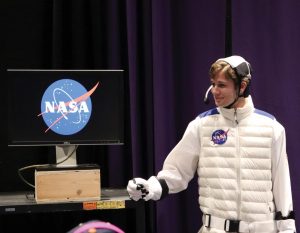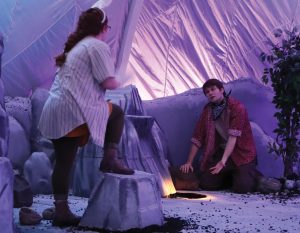Play created for kids on autism spectrum
Apr 18, 2019
An original play tailored to young individuals with developmental disorders or autism is the culmination of 18 months of collaboration between over 20 UNI students and faculty members.
In many theater productions, a narrative arch will be followed from the beginning, middle and end. The audience watches the actors perform their memorized lines, and after it’s done, they give a round of applause. However, the production of “To Touch the Moon” will feature elements and concepts which aren’t typically seen in a play.
“This is an immersion theater piece,” said Gretta Berghammer, professor of drama and theater for youth. “There’s a story spine, but the 15 participants add to the story through choices, decisions and engagement.
Rather than having one plot, Berghammer said that the play is tied together by overall themes.
“The overall theme to all of ‘To Touch the Moon’ is discovery and exploration,” she said. “What we’re trying to do here with this piece is to help young people feel what it’s like to discover something for the first time.”
“To Touch the Moon” was inspired the 50th anniversary of the first moon landing this year. Berghammer was 13 years old when it happened, and she said she found it to be astonishing. This play production is meant to recreate that sense of wonder.
The sold-out show will present a total of six performances that will be held from April 19 to 20 and April 26 to 28. It will be performed in Bertha Martin Theatre.
Berghammer believes that her immersive theater experience is similar to a museum.
“Imagine that there’s this amazing science museum,” she said. “It’s got all kinds of really cool things and a really cool environment with the moon and NASA. Then you bring in 15 of your favorite actors and do something in that space.”
Those who walk into the doors of the theater will be taken on an “expedition” of sorts, in which they pair up with a partner and explore things. The kids within the production will receive a backpack with tools, such as a magnifying glass. From there, participants will get to practice scooping rocks, measuring them and putting them into vials.
Once this is done, audience members will get to explore trees, water and more. They will then be led into a campsite-like space in which people will share stories about the moon. The exact content of each event will depend on the participants’ questions and curiosity.
Producing an experience with several sets and components presented some challenges.
“You have three different locations that have to be designed, and then you have to figure out how to transition to each environment,” Berghammer said. “Episode One involves exploration of a brand-new rock formation in Iowa during the present day. Episode Three is the moon. Are there elements from Episode One that we can reuse in Episode Three by changing things slightly to create the moon?”
In order to create an immersive space experience, they also had to build things such as a lunar excursion module and a recreation of NASA’s Building Nine. To assist with building these technical components, they received donations from places such as the Iowa Space Grant Consortium. As part of her preparation for the play, Berghammer also visited a space camp and talked to astronauts and NASA historians.
While Berghammer put in time and training to create this production, she wanted to let the students know that she was proud of the work they had done. She is also grateful towards her colleagues for supporting the unique nature of her project.
When the play begins on April 19, she hopes that the kids will be able to enjoy it.
“Everything I do is for the kids,” said Berghammer. “My favorite part is watching young people engage in theater, because that’s what I’m curious about.”











